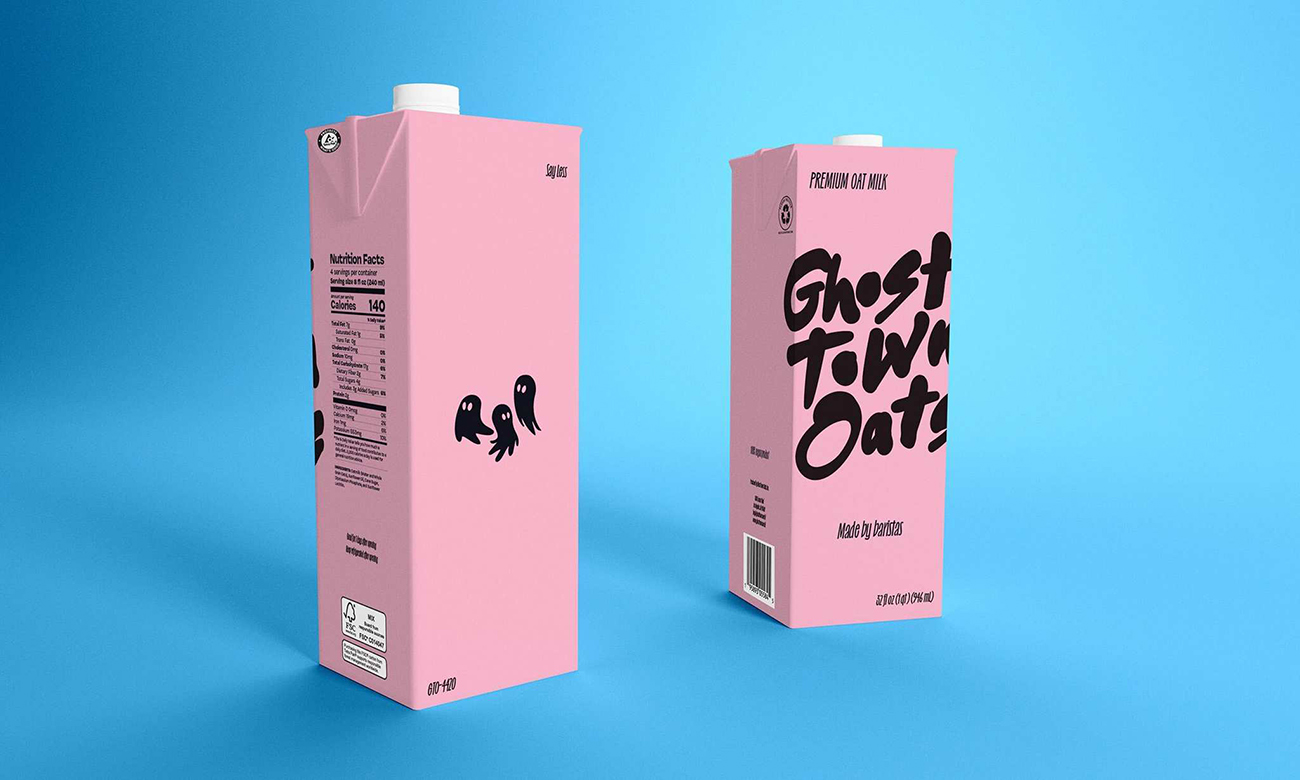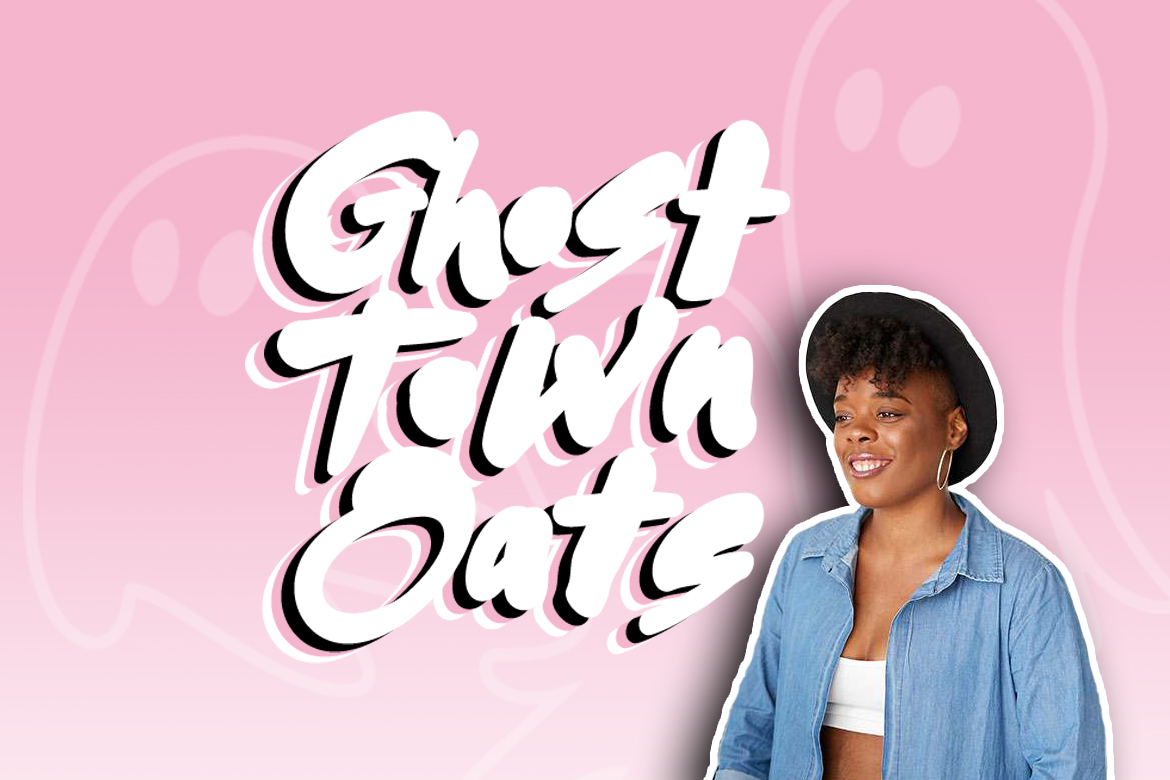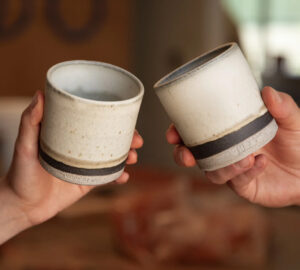What a time to be an alternative milk drinker. Where there was once only Silk soy milk and Almond Breeze almond milk, the alt-milk landscape has exploded in recent years, and now practitioners of the lactose-free arts are spoiled with choice. The uptick in popularity of dairy alternatives has gone hand in hand with the meteoric rise of oat milk, ushered in by leading brands like Pacific Barista Series, Oatly, and Califia Farms, just to name a few.
In case the Super Bowl ads and packed grocery store shelves hadn’t already let on, oat milk has officially gone mainstream. But even in its ubiquity, there has always been a question of who, exactly, is oat milk for? Is it for the third wave coffee acolytes, the lactose intolerant, the plant-based? The answer is yes: alternative milk is for everyone.
Enter Ghost Town Oats, a new oat milk company based in Los Angeles. Created by high-profile industry veterans Michelle Johnson (The Chocolate Barista), Ezra Baker (No Free Refills Podcast), and Eric J. Grimm (Glitter Cat Barista Bootcamp), Ghost Town is a continuation of the trio’s combined four decades of experience championing diversity and inclusion in the world of specialty coffee. With their new brand, the team have focused on offering oat milk to underserved communities of color, which some research has linked to higher rates of lactose intolerance.
Ghost Town Oats has quietly begun rolling out to coffee bars in the Los Angeles area and currently has a waitlist of over 100 cafes nationwide interested in carrying their oat milk. And now the brand is seeking $1 million in funding via WeFunder. Unlike traditional crowdfunding sites like Kickstarter or GoFundMe, WeFunder offers backers a chance to earn equity in a company with their investment, which can be as small as $100.
Corresponding with the launch of the WeFunder campaign, we spoke digitally with Michelle Johnson to learn more about Ghost Town Oats, the WeFunder campaign, and what the future holds for the new oat milk brand.
This interview has been lightly edited and condensed for clarity.

First and foremost, why oat milk? You all have done so much work in your careers to champion diversity and inclusion in the coffee industry. How did oat milk become the conduit to further your collective mission?
This crew goes hard for cappuccinos and it’s clear that plant-based milk is taking over our capps. But seriously, oat milk is swiftly becoming our new supreme. From where we stand, we see whole swaths of people from every background adopting oat milk as the milk of choice. So why does it still lean to appeal to the white and upper class? If a healthy, sustainable, plant-based lifestyle is what we’re hoping to adopt on a grand scale, then you have to consider what the people out on the margins need in order to reach everyone.
We saw early that there was a missed opportunity—even superficially on a marketing level—not including communities of color, in particular. We’re generally more likely to experience lactose intolerance, and Black Americans are 2-3 times more likely to be vegan specifically. Ubiquity is possible if, and only if, everyone is on board. If that hurts our planet a little bit less, awesome. But the focus at Ghost Town is getting something delicious and better for you to as many of you who want it as possible.
Your press materials discuss redefining oat milk culture and bringing oat milk to a more diverse crowd. Being a Black-owned and Queer-owned company in this space is itself doing much of that work, but what will this mean for the consumer?
It means lifestyle inclusivity. Many of the products we consume sell a specific lifestyle we’re striving for and oat milk is no different. It’s closely tied to a class of society that has the means to center health and wellness in their lives. But the majority of us are out here doing what we can with what we have, and we acknowledge that at Ghost Town. We’re meant to fit into your life however you see it making sense. In practice, that looks like identifying common denominators between socioeconomic demographics that’ll provide the lowest barrier to entry: coffee shops and convenient stores to start.
We’ve seen coffee culture evolve within the last decade to become more vibrant and rich with flavor—if you know what I mean. Our team knows this intimately because we’re some of the drivers behind it. So it would be silly of us to discredit how influential coffee shops are to the adoption of a product like oat milk (We see you, Oatly!), especially considering how many more Black folks and people of color are frequenting, owning, and operating coffee businesses nowadays! Plus the coffee industry is where we earned our stripes, and we’re happy to first share this product with those who have built us up and cheered us on over the years.
To go even further to reach people, we’re working to get into convenience stores. Think about it: not every zip code has a grocery store within a reasonable distance and a reliable way to get there. But a 7-Eleven, gas station, bodega, or a corner store are always nearby. It’s the closest we can get to everybody next to e-commerce direct-to-consumer options, which we’ll also begin to attack with serious intentionality this year. Even prior to being available, we soft launched this past weekend at Black Market Flea in Los Angeles via a coffee pop-up co-founder Michelle Johnson and Director of Relationships Eric J. Grimm had established there already.
The methodology that informs our strategy is rooted in us being baristas, and baristas with identities at the margins at that. We have a hospitality-forward mindset, naturally, and come from backgrounds that center making sure everybody eats. Meeting people where they are now is built into the core of this company and our starting point versus something that’s treated as an afterthought in a marketing strategy.

Where are the oats sourced from? Tell us a little bit about the process of creating an oat milk from the ground up?
We work closely with a manufacturing partner in New York that sources oats from a variety of American farms, similarly to how roasters just starting out, like we are, work with an importer to source green coffee.
The process to creating an oat milk was a journey! It began with a “Pepsi Challenge” tasting and evaluating as many brands of oat milk we could find—from major players like Oatly, Califia Farms, Chobani, and Pacific Foods to some brands not as widely known like Willa’s. After noting our likes and dislikes of each brand, we asked ourselves what we, as professional baristas who’re also a part of the culture, wanted out of an ideal oat milk. Taste and versatility became the highest priorities.
We shared our desired outcomes for texture, mouthfeel, flavor profile, and function to our manufacturer then went through a series of evaluating lab samples over the summer of 2021. During this process, we were consulted by food scientists who not only helped us vet our manufacturer but also connected the dots between what we were looking for in taste and the right ingredients necessary to make it happen.
Creating an oat milk across the country from the manufacturer also came with issues. Los Angeles weather in the summer is unforgiving to not-shelf stable lab samples, and half of our team weren’t able to evaluate the last two rounds of samples. But Ezra Baker, Director of Operations and Certified Q-Grader based in New York City, was vital in finalizing the formula for our production. We trusted him and his palette completely, and he approved the result we have today!
Over the last quarter of the year, we ordered ingredients, set up our relationship with TetraPak, designed packaging, and scheduled a pilot trial of which we took a portion of for sampling. By January, we were tasting our first iteration of Ghost Town Oats and that moment was incredible.
The entire process took about 13 months from company formation in December 2020 to enjoying the first production sample. Now we’re ready to begin “Chapter 0” (everything before now was the foreword) which is the fundraising phase.
You’re raising capital via WeFunder, which is lesser-known than a GoFundMe or Kickstarter. Can you tell a little about how the campaign will work? How much are you looking to raise?
We’re looking to raise $1M. WeFunder is an equity crowdfunding platform versus a donation-based crowdfunding option like GoFundMe or selling perks like Kickstarter. On WeFunder, anyone can buy in for as little as $100 and actually receive equity in the company! This is a process traditionally meant for accredited investors, and there are plenty of founders who raise a “friends & family” round of investment before pursuing angels and venture capital. WeFunder allows us to create an opportunity to become many people’s first investment, opening up that barrier to entry. We’re seeing a collective shift towards people wanting to invest their money through stocks, crypto, and supporting the companies that add value to their lives. We couldn’t have found a better way to continue to push that forward in a meaningful way that has the potential to create a pathway for building generation wealth.
Anyone who contributes will receive equity in the company. The amount of equity they receive will depend on the total valuation we set for the company, which is still TBD, but will be communicated soon!

Ghost Town is initially rolling out to four coffee companies, when do you expect that to take place? Where does the rollout go from there?
We just completed our trial run and we’re happy to report that it’s fucking delicious. We’re beginning to taste test on bars across Los Angeles and realizing that casting a wider net for rollout makes more sense.
If there’s anything we’ve learned about producing consumer packaged goods, it’s that everything takes longer than expected! So our first production run is looking like it’ll begin late March/early April, at which point, we’ll begin a steady but aggressive rollout to Los Angeles and beyond. Our waitlist currently sits at 100 interested coffee companies! We’re planning to continue doing pop up events, like Black Market Flea in Los Angeles, for example. Additionally, we’re hoping to activate cafes to become pantry shops and sell cartons of Ghost Town to their customers as we work out distribution. Just like a ghost, you’ll first begin to hear whispers of Ghost Town around then suddenly you’ll see us EVERYWHERE.
When/where/how will consumers be able to get their hands on some Ghost Town?
Right now, you can expect to see us at Black Market Flea once a month in Los Angeles where we serve a delicious menu of ready-to-drink oat milk-based specialty lattes. Look out for us this summer at your favorite coffee shop and in a convenience store near you by 2023!
Thank you!
Zac Cadwalader is the managing editor at Sprudge Media Network and a staff writer based in Dallas. Read more Zac Cadwalader on Sprudge.































